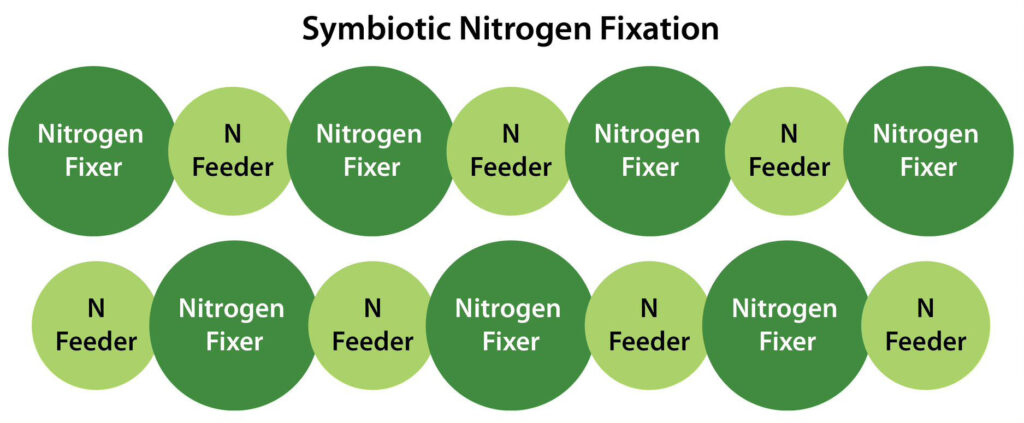Companion Planting & Botanical Pesticides: Concepts & Resources

Buckwheat (left) suppresses weeds and attracts beneficial insects that can help protect brassicas (right). Photo: Andy Pressman, NCAT
By George Kuepper, NCAT Agriculture Specialist, and Mardi Dodson
Updated April 2016 by Justin Duncan, NCAT Agriculture Specialist
Abstract
Certain plants can benefit others when planted in close proximity or used as botanical pesticides. This publication discusses the scientific and traditional basis for companion planting associations including trap cropping, weed suppression, physical-spatial interactions, and other relationships. It provides a companion planting chart for common herbs, vegetables, and flowers, as well as a listing of literature resources. An appendix provides information on the Three Sisters, a traditional Native American companion planting practice.
Traditional Companion Planting
Companion planting can be described as establishing two or more plant species in close proximity for some cultural benefit (such as pest control or higher yield). The concept embraces a number of strategies that increase the biodiversity of agroecosystems (Cunningham, 1998).
Generally, companion planting is thought of as a small-scale gardening practice. However, here the term is applied in its broadest sense to include applications to commercial horticultural and agronomic crops. ATTRA has another publication, Intercropping Principles and Practices, that provides additional information on larger-scale applications.
Although companion planting has a long history, the mechanisms of beneficial plant interaction have not always been well understood. Traditional recommendations (see Table 1) used by gardeners have evolved from an interesting combination of historical observation, horticultural science, and a few unconventional sources. For example, some of the recommendations for companion planting, made around the middle of the 20th century, were based on the results of sensitive crystallization tests (Philbrick and Gregg, 1966).
A step beyond companion planting is using botanically based pesticides. Companion planting is a passive approach, while botanical sprays are more intensive. Both rely on phytochemicals in the host plant being different from the companion plant, or the one being treated. One consideration for using a botanical spray that is different from simply planting a companion is that the botanical spray may affect the host plant’s development (Tavares et al., 2011). The same can be said of synthetic pesticides (Spiers et al., 2008).
The Scientific Foundations for Companion Planting
Science has routinely provided evidence that supports some facets of sustainable agriculture, like companion planting. While the scientists may not call their work companion planting per se, the results of their work show that there is potential for home gardeners and small farms to capitalize on the natures of plants to affect each other’s growth. Whether these plants harbor beneficial insects, release nutrients advantageous to another crop’s growth, or simply provide a buffer against the elements to tender seedlings, the tenets of companion planting have been shown repeatedly through rigorous scientific experimentation to be beneficial to planting systems.
Trap Cropping
Sometimes, a neighboring crop may be selected because it is more attractive to pests and serves to distract them from the main crop. An excellent example of this is the use of collards to draw the diamondback moth away from cabbage (Mitchell et al., 2000).
Trap cropping breaks into several sub-categories: Conventional, Sequential, Multiple, Push-Pull, Dead-End, Perimeter, Semiochemically Assisted, Biological Control-Assisted, and Genetically Modified Trap Cropping (Shelton and Badenes- Perez, 2006). Trap crops should be as healthy as possible to ensure their desirability to their targeted pest species (Mizell et al., 2008).
Conventional Trap-Cropping is simply planting a low-value crop that is more attractive to pests than the adjacent higher value crop, as in the example of the diamondback moth, above. The classic and most economically beneficial example of this is attracting Lygus bugs away from cotton fields by planting alfalfa nearby (Godfrey and Leigh, 1994). The alfalfa must be kept physiologically young with repeated mowing in order for it to remain attractive to Lygus throughout the season. Trap crops are often destroyed as a means of pest control (Hokkanen, 1991).
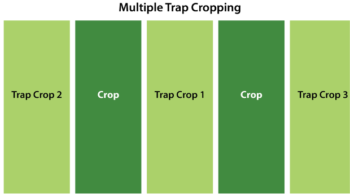
Sequential Trap Cropping uses time to separate pests from valuable crops. Escape by time is already a common practice in sustainable agriculture (Feeny, 1976) so it makes sense that time is also used in trap cropping. Trap crops are planted ahead of the main crop, and the timing of these traps crops can be critical. For example, in one study, strawberry seedlings planted alone had a 43% mortality rate from wireworms, strawberry seedlings planted two weeks before being intercropped with wheat had a 27% mortality rate, and strawberry seedlings only had a 5% mortality rate when wheat was planted eight days in advance (Vernon et al., 2000). This set-up could also be considered a nurse crop in a sense. Usually nurse crops protect from climatic adversity, but in this case the nurse crop is protecting the strawberry seedlings from attack by wireworms.
Multiple Trap Cropping usually involves several different species of crops to maintain attractiveness to the pest throughout the growth cycle of the crop (Hokkanen, 1989). One such system, recommended by researchers at the University of Florida for controlling stink bugs and leaf-footed bugs, is to grow Triticale, Sorghum, Pennisetum (millet), buckwheat, and sunflowers around the perimeter of the cash crop (Mizell et al., 2008).
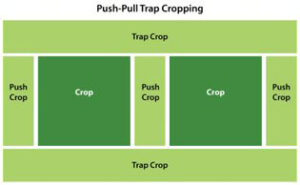
Push-Pull Trap Cropping combines an attractant border crop with a repellant intercrop to protect crops from pests. The most successful version of this method was developed in Kenya to reduce damage from boring insects in corn. They use a legume, Desmodium, to repel pests (and also fix more than 300 pounds of nitrogen per acre) (Whitney, 1966) and use Pennisetum as an attractant (Pickett et al., 2014). This technology has been adopted by more than 10,000 farmers (Khan et al., 2014). Also known as stimulo-deterrent trap cropping (Miller and Cowles, 1990), this idea represents a revolutionary option for organic and sustainable producers. Not only is it easily adapted, but it also has strong foundations in scientific research.
Dead-End Trap Cropping is most useful when positioned to buffer crops from adjacent pest sources, as with other trap-crop techniques (Shelton and Badenes-Perez, 2006). In Dead-Ending, the trap crop is attractive to the target pest but the larvae are unable to complete their life cycle on the trap crop. One example is the use of Crotalaria juncea to attract the pod-boring Maruca vitrata away from such crops as cowpeas, pigeon peas, and soybeans and kill 50-100% of their larvae (Jackai and Singh, 1983).
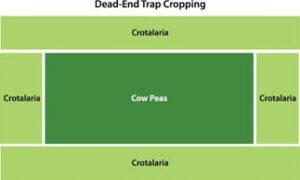
Semiochemically Assisted Trap Cropping makes use of pheromones rather than kairomones (Shelton and Badenes-Perez, 2006). Semiochemicals are chemicals that carry a message, while a kairomone is a semiochemical that may not benefit its emitter. Plants emit kairomones and insects benefit from them in some way, such as using the plant as a food source. Pheromones, on the other hand, are semiochemicals that affect members of the same species; e.g., mating semiochemicals from receptive females alerting males to their receptivity. In field applications, these chemicals can be used to draw pests away from the cash crop to be destroyed in the trap crop. For example, one experiment found that an application of Dimethyl Disulfide attracted predators of the cabbage root fly, Delia radicum, resulting in a 60% egg mortality rate (Kergunteuil et al., 2012). This research also showed potential for (Z)-3-hexenyl acetate, a kairomone released from damaged leaves that encourages pest oviposition, to be used in trap cropping. From their work, we can surmise that mechanically bruised crops will encourage females to deposit their eggs in the damaged area, which could then be sprayed or otherwise destroyed, leaving the main body of the crop relatively pest-free. The drawbacks of using semiochemicals are that they can be expensive and hard to find for specific pests. For example, none exist, as of yet, for stinkbug pests (Mizell et al., 2008). Rincon Vitova (www.rinconvitova.com) has semiochemicals for some other pests available for purchase.
Biological Control-Assisted Trap Cropping (BCATP) combines concepts of farmscaping and trap cropping. Trap cropping makes use of the verges of the fields to draw pest populations away from crops. BCATP not only draws the pests but also their natural enemies. These trap crops also serve as sources of biological controls for adjacent fields, to further reduce pest incidence. One example is cotton bollworms being controlled by predators in sorghum plots adjacent to cotton fields (Tillman and Mullinix, 2004; Virk et al., 2004).
Genetically Modified Trap Cropping makes use of GMO traits to assist in crop protection. Crops with the Bacillus thuringiensis (Bt) trait can be planted earlier than conventional crops to collect migrating pests that cannot survive the toxins produced by the plants. When the conventional crops are planted, they will be under much less pest pressure due to the early generations of the pest population being wiped out by the transgenic trait (Cao et al., 2005). The erosion of Bt trait efficacy may lead to reduction in the amount of pests destroyed by this method (Tabashnik et al., 2013). For more information on GMO traits, please refer to the ATTRA publication Transgenic Crops.
Symbiotic Nitrogen Fixation
Legumes – such as peas, beans, and clover – have the ability to fix atmospheric nitrogen for their own use and for the benefit of neighboring plants via symbiotic relationships with Rhizobium and Bradyrhizobium bacteria. One example of a crop benefiting from interplanted legumes is that of beans and potatoes. Potatoes are known to be heavy nitrogen feeders. In one experiment, potatoes were planted with beans (Phaseolus vulgaris) or with corn. While the corn, also being a heavy feeder, was shown to reduce potato-tuber size, beans did the opposite (Manorama and Lal, 2010). Similarly, forage legumes are commonly seeded with grasses to reduce the need for nitrogen fertilizer. Likewise, fava beans are sometimes interplanted with corn. Some research indicates that this companion-planting duo is beneficial in desert reclamation where both nitrogen and phosphorous levels are low (Mei et al., 2012).
Another use for legumes is as a green manure crop. Green manures are crops that are grown to be killed and then incorporated into the soil, or left as mulch to increase soil organic matter and, in this case of legumes, nitrogen. A Canadian study showed that by incorporating grazing sheep into the rotation, soil nitrogen could be increased, as well as the animals’ weight-gain (Cicek et al., 2014).
Weed Suppression
One other benefit of legumes and other vining crops, such as cucurbits, is the suppression of weeds. A well-known example is the role squash plays in the Three Sisters Method of growing beans, corn, and squash. In this situation, the squash plants’ prostrate vines form a dense canopy and smother weed competition. Other companion growing systems have also used corn but exchanged squash for Desmodium, which has a three-fold role. First, it suppresses Striga, a parasitic vine that devastatingly reduces corn yields in Africa. Inclusion of a Desmodium companion crop triples corn yield over corn planted in monocrop. It appears that Striga germination is suppressed by the presence of Desmodium. Next, the Desmodium fixes nitrates for the corn crop, which also lowers input needs. Third, the Desmodium is a forage legume that provides producers with a secondary source of income in the form of fodder once the corn crop is finished. This system has but one draw-back: it is highly labor-intensive, requiring twice the labor of corn monoculture. In short, it’s twice the work yet triple the revenue per acre (Midega et al., 2014). Another unmentioned benefit could have been the manipulation of the root zone to benefit the corn plants. Although Striga is an African problem, U.S. producers can adapt the methodology that African producers use to address similar challenges here.
In a recent study, researchers failed to find conclusive results as to whether organic production reduced weed seeds through soil microbial action (Ullrich et al., 2011). From our own experiences, we have found that in organic production, weed-seed persistence is reduced by cover crops in rotation providing a dense canopy when the weed seeds are germinating. This dense canopy starves the weed seedlings from light and thus kills them. This method takes quite a while, but over the course of a few cycles, pernicious weeds like Amaranth, nutsedge, and Bermuda grass can be reduced. One must remember that organic agriculture is an intricate system that utilizes the harmonious balances in nature for human benefit. Attempting to pick it apart like a machine may not give the desired results.
Modification of Root-Zone Environment
 Companion plants can act as living mulches. One of our favorite combinations is that of broccoli and crimson clover. Research in Hawaii showed that this combination increases the amount of spiders that patrol the broccoli plants to control pests (Hooks et al., 2007), but what we value is the way the clover protects soil moisture and keeps the soil cooler for the broccoli. In addition to cooling the soil, a companion cover crop can improve other factors-tilth, soil structure, runoff control, and water-holding capacity-and also build up soil organic matter (Hartwig and Ammon, 2002; Folorunso et al., 1992). In gardening situations where deciduous trees are nearby, the canopy provides shade for sun-tender vegetables, but more importantly the leaf litter adds potassium and carbon to the soil. The increased organic carbon content in turn increases water-holding capacities and Cationic Exchange Capacity, or CEC. Thus, trees contribute to soil carbon sequestration in two ways: first they add carbon through leaf decomposition and then protect it from volatile decomposition by shading the material, not counting the carbon the trees acquire in growth. If the tree is a nitrogen-fixing legume, then there is also an increase in soil nitrates (Tanga et al., 2014). The presence of either trees or cover crops allows mycorrhiza populations to build up in the soil as well (Augé, 2001). Mychorrhiza are soil fungi that form mutually beneficial associations with plant roots. They can harvest nutrients for plants and even water in time of drought (Kaya et al., 2003). This is particularly useful in vineyards and orchards (Linderman and Davis, 2001; Schreiner, 2004). Mychorrhizal colonization can even influence visits by pollinators (Barber and Soper Gorden, 2014). Mychorrhiza-treated tomatoes showed more total yield and more marketable yield than tomatoes without mycorrhiza treatment (Candido et al., 2015). Mycorrhiza must have plant roots to join with, so intercropping cover crops with vegetables or permanent plantings allows a grower to extend the reach of the mychorrhizal hyphae throughout the garden or farm.
Companion plants can act as living mulches. One of our favorite combinations is that of broccoli and crimson clover. Research in Hawaii showed that this combination increases the amount of spiders that patrol the broccoli plants to control pests (Hooks et al., 2007), but what we value is the way the clover protects soil moisture and keeps the soil cooler for the broccoli. In addition to cooling the soil, a companion cover crop can improve other factors-tilth, soil structure, runoff control, and water-holding capacity-and also build up soil organic matter (Hartwig and Ammon, 2002; Folorunso et al., 1992). In gardening situations where deciduous trees are nearby, the canopy provides shade for sun-tender vegetables, but more importantly the leaf litter adds potassium and carbon to the soil. The increased organic carbon content in turn increases water-holding capacities and Cationic Exchange Capacity, or CEC. Thus, trees contribute to soil carbon sequestration in two ways: first they add carbon through leaf decomposition and then protect it from volatile decomposition by shading the material, not counting the carbon the trees acquire in growth. If the tree is a nitrogen-fixing legume, then there is also an increase in soil nitrates (Tanga et al., 2014). The presence of either trees or cover crops allows mycorrhiza populations to build up in the soil as well (Augé, 2001). Mychorrhiza are soil fungi that form mutually beneficial associations with plant roots. They can harvest nutrients for plants and even water in time of drought (Kaya et al., 2003). This is particularly useful in vineyards and orchards (Linderman and Davis, 2001; Schreiner, 2004). Mychorrhizal colonization can even influence visits by pollinators (Barber and Soper Gorden, 2014). Mychorrhiza-treated tomatoes showed more total yield and more marketable yield than tomatoes without mycorrhiza treatment (Candido et al., 2015). Mycorrhiza must have plant roots to join with, so intercropping cover crops with vegetables or permanent plantings allows a grower to extend the reach of the mychorrhizal hyphae throughout the garden or farm.
Biochemical Pest Suppression
As mentioned above, some plants exude chemicals from roots or aerial parts that suppress or repel pests and protect neighboring plants. Certain marigolds, for example, release thiophene-a nematode repellent-making marigold a good companion for a number of garden crops (Marotti et al., 2010). The manufacture and release by a plant of certain biochemicals, known as allelochemicals, can negatively impact the growth of other plants. Allelochemicals such as juglone-found in black walnut- suppress the growth of a wide range of other plants, which often creates a problem in home horticulture. The means by which this suppression occurs is mitosis inhibition, which in turn reduces meristematic activity. In short, the juglone acts as a growth retardant on other plants by interfering with the ability of the cells to divide (Babula et al., 2014).
A positive use of plant allelopathy is the use of mow-killed grain rye as a mulch. The allelochemicals that leach from rye residue prevent weed germination but do not harm transplanted tomatoes, broccoli, or many other vegetables. Rye can be flattened with a roller-crimper and crops such as melons can be transplanted into the residue. In this manner, melon yield is enhanced, weed pressures are lowered, and the soil is protected by the rye mulch from both desiccation and erosion (Ciaccia et al., 2015). Rye is known to have 16 different allelopathic chemicals (Schulz et al., 2013) and is considered one of the best crops for weed seed suppression (Jabran et al., 2015).
Masking is an offshoot of biochemical pest suppression. It makes use of volatiles to prevent a pest from attacking its favored host. One such example is the use of garlic and other Alliums in the garden. These have been found to deter the green peach aphid (Amarawardana et al., 2007). If the insect is searching for its host when it encounters a field with vegetables companion-planted with Alliums, the pest primarily smells the overpowering volatile Allium semiochemicals. The pest continues its search because the scent of the susceptible host plant was ‘masked.’
Physical Spatial Interactions
In one example of such an interaction, tall-growing, sun-loving plants may share space with lower-growing, shade-tolerant species, resulting in higher total yields from the land. Spatial interaction can also yield pest-control benefits. The diverse canopy resulting when corn is companion- planted with squash or pumpkins is believed by proponents of Three Sisters planting to disorient the adult squash vine borer and protect the vining crop from this damaging pest. In turn, the presence of the prickly squash vines is widely believed to discourage raccoons from ravaging the sweet corn. Besides the classic corn example, there is also supporting research that shows that in a cowpea-sorghum companion planting, cowpeas were protected from the striped bean weevil due to the physical barrier of the tillering sorghum (Amoako-Atta, 1983).
We often think of the benefits of companion planting as limited to reducing pests, but it can also be effective in reducing plant diseases. In a pea-grain intercrop, Ascochyta blight severity was significantly reduced although there was no change in disease development. The grain intercrop modified the canopy microclimate by making it less humid, and it also reduced the raindrop splash effect, the means by which the disease spores are spread (Schoeny et al., 2008). Canopy microclimate can also influence insect development. Temperature changes due to canopy architecture caused moths to develop three days faster in a compact canopy versus a more open one (Kührt et al., 2006). More on spatial arrangement can be found in the ATTRA publication Intercropping Principles and Practices.
Nurse Cropping
Tall or dense-canopied plants may protect more vulnerable species through shading or by providing a windbreak. Nurse crops such as oats have long been used to help establish alfalfa and other forages by supplanting the more competitive weeds that would otherwise grow in their place. In many instances, nurse cropping is simply another form of physical-spatial interaction. It can also be a form of inter-seeding. Our earlier example from sequential trap cropping, with the strawberries, can also be considered nurse cropping. Usually a nurse crop protects from climatic adversity, but in this case it is protecting the strawberry seedlings from insect predation (Vernon et al., 2000). Many times, nurse crops are used in association with forages, where a fast-germinating grass is used with a slower-growing legume (Weller, 2006).
Beneficial Habitats
Beneficial habitats—sometimes called refugia or insectary plantings, farmscaping strips, etc.—are another type of companion plant interaction that has drawn considerable attention in recent years (Philips et al., 2014). The benefit is derived when companion plants provide a desirable environment for beneficial insects and other arthropods-especially those predatory and parasitic species which help to keep pest populations in check. Predators include ladybird beetles, lacewings, hover flies, mantids, robber flies, and non-insects such as spiders and predatory mites. Parasites include a wide range of fly and wasp species including tachinid flies and Trichogramma and ichneumonid wasps. Agroecologists believe that by developing systems to include habitats that draw and sustain beneficial insects, the twin objectives of reducing both pest damage and pesticide use can be attained. Numerous (552) experiments over a ten-year period were examined to find whether Farmscaping (also known as environmental engineering) was an effective method of reducing pest populations. The answer was a resounding yes, but it was at a cost of production of the main crop (Letourneau et al., 2011).
Security Through Diversity
A more general mixing of various crops and varieties provides a degree of security to the grower. If pests or adverse conditions reduce or destroy a single crop or cultivar, others remain to produce some level of yield. Furthermore, the simple mixing of cultivars, as demonstrated with broccoli in University of California research, can reduce aphid infestation in a crop (Daar, 1988). Research supports the concept that diverse crops add to total biomass yield (Mousavi and Eskandari, 2011) and that risk in multi-cropping situations is inherently lower than in monocultures. This increase can be attributed to a more efficient consumption of soil nutrients per unit area (Eskandari and Ghanbari, 2009).
Botanical Pesticides
The great thing about botanical pesticides is that they can be made at home using common ingredients. For example, many gardeners enjoy the beauty and sometimes the flavor of nasturtiums. Others grow them for their insect-repelling properties as a companion plant, but nasturtiums have also been shown to have larvacidal effects on leafminers. A methanol extraction of finely chopped nasturtium leaves caused almost 20% reduction in coffee leaf miners (Alves et al., 2013). The same kind of extract from a four-o’clock plant killed 50% of the coffee leaf miners, and extract of high mallow and guinea-hen weed killed 60%! Nasturtium phytochemicals were found to be more or less abundant depending upon the preparation technique used. For example, using heat during the extraction lowered the available phytochemicals. Changing the extraction method also affected phytochemical content (Bazylko et al., 2013). Extracted solutions also differed from fresh-squeezed juice in amounts of flavonoids and phenols (Bazylko et al., 2014). Aside from extraction processes, secondary metabolites in plants can also be influenced by climatic conditions and even UV radiation (Rozema et al., 1997). These factors can either enhance or detract from a given plant’s successful use as a source of a botanical pesticide and should be taken into account regarding efficacy. While every batch may not have the same exact effectiveness, the ability to make the botanical pesticides at home at your leisure more than compensates for any variability. You may choose to use a blender or juicer if possible, but this will also alter the antioxidant activity (Pyo et al., 2014).
A very common botanical pesticide is neem oil. Neem (Azedirachta indica), a tree in the Meliaceae, is closely related to the invasive chinaberry (Melia azedarach), native to Asia, and has been introduced to many parts of the world due to its beneficial properties (Sherley, 2000). The oil is derived from the seeds. Neem has been found to contain 99 insecticidal phytochemicals including the powerful antifeedant azadirachtin. Neem has been found to be one of the best tools for biological production systems. It works in two ways: the first is its aforementioned antifeedant property; the second is that it wreaks havoc on the insects’ physiology. This latter effect prevents molting and leads to sterility. So an application of neem is both preventative and curative (Schmutterer, 1995).
Neem also has fungicidal affects and can be useful in reducing symptoms of several garden pathogens (Govindachari et al., 1998). Leaf extracts from the neem tree are also effective (Wondafrash et al., 2012), although a bit less effective than the seed extracts. In both of the previous experiments, when they tested various individual components purified from the mix, none were as effective as the crude form. This is commonly the case, since plant constituents are often synergistically active and additively effective. Neem’s cousin, the chinaberry tree, contains similar phytochemicals and a few extra meliatoxins that are harmful to mammals. However, some forms of the Chinaberry tree are without those specific toxins because the species widely varies from one area of adaptation to another.
Pyrethrum is often used in conjunction with other pesticides in biological agriculture. Pyrethrums are knock-down killers, fast acting and broad spectrum. They are effective against a range of pests: ants, soft-bodied insects, beetles, moths, leafhoppers, spider mites, stink bugs, thrips, webworms, flies, pantry pests, and mosquitoes. Pyrethrum has been used to kill insects for hundreds of years. On the other hand, there are quite a few instances of insects overcoming not only pyrethrum but also synthetic versions of the pesticide.
Many plants express insecticidal traits. The key to using them for your benefit is using them on plants that are very dissimilar and thus produce different phytochemicals. For example, nasturtiums repel many pests, but they are in the Brassica family and thus would be mostly ineffective against cabbage moths or other pests of Brassicas because their phytochemicals would attract more of the pests.
A simple botanical pesticide can be prepared from four good-sized garlic cloves blended into one quart of water. After blending, let the solution sit for 10 to 15 minutes, then strain. Straining through cheesecloth or a fine sieve is essential to remove the small particles that would clog a sprayer. The solution should all be used as soon as possible; it is not meant to have a long shelf life.
One drawback of homemade botanicals is that there is no standard for efficacy. They work for however long they will work and then need to be reapplied. It’s best to have plenty of source material planted around the garden and set aside for this use. When harvesting your source material, use the same rule as for harvesting leafy vegetables: generally, pick less than 1/3 of the plant in order to give it sufficient leaf mass needed to recover.
Botanical sprays can be effective and cheap. They are truly a renewable resource that is an aid in reducing hotspots of insect pest activity in the garden or on the farm. Combining their use with the various companion planting methods can increase their effectiveness and reduce pest pressure.
Options for System Design
Agronomists use the term “intercropping” to describe the spatial arrangements of companion planting systems. Intercropping systems range from mixed intercropping to large-scale strip intercropping. Mixed intercropping is commonly seen in traditional gardens where two or more crops are grown together without a distinct row formation. Strip intercropping is designed with two or more crops grown together in distinct rows to allow for mechanical crop production. No-till planting or transplanting into standing cover crops can be considered another form of intercropping. For more information on no-till planting, request the ATTRA publication Reducing Tillage Intensity in Organic Production Systems.
Appendix: Ancient Companions
By Mardi Dodson
Introduction
For centuries, many Native American tribes throughout North America have cultivated corn, beans, and squash. The term “Three Sisters” was primarily used by the Iroquois who live in the Northeastern United States and Canada. These crops were considered to be special gifts from Great Spirit and were believed to be protected by the Three Sisters-spirits collectively called the De-o-ha-ko, meaning “our sustainers” or “those who support us” (Eames-Sheavly, 1993).
This ancient style of companion planting has played a key role in the survival of all people in North America. Grown together, these plants are able to thrive and provide high-yield, high-quality crops with a minimal environmental impact. Corn, beans, and squash have a unique symbiotic relationship in a Native American garden. Corn offers a structure for the beans to climb. The beans, in turn, help to replenish the soil with nutrients. And the large leaves of squash and pumpkin vines provide living mulch that conserves water and provides weed control.
Corn
Corn is considered the most important of all Native American crops. Originating in South America and Mexico, corn was introduced during the Mississippian Period (600 A.D. to 1450 A.D.) to North American tribes via an intricate series of trade networks. Corn, beans, and squash combine to create a nearly perfect meal loaded with essential vitamins and minerals (Erney, 1996). In addition to its nutritional values, all Native American tribes that grew corn considered it a sacred and spiritually valuable plant.
The Legend of the Three Sisters
The term “Three Sisters” emerged from the Iroquois creation myth. It was said that the earth began when “Sky Woman” who lived in the upper world peered through a hole in the sky and fell through to an endless sea. The animals saw her coming, so they took the soil from the bottom of the sea and spread it onto the back of a giant turtle to provide a safe place for her to land. This “Turtle Island” is now what we call North America.
Sky Woman had become pregnant before she fell. When she landed, she gave birth to a daughter. When the daughter grew into a young woman, she also became pregnant (by the West wind). She died while giving birth to twin boys. Sky Woman buried her daughter in the “new earth.” From her grave grew three sacred plants-corn, beans, and squash. These plants provided food for her sons, and later, for all of humanity. These special gifts ensured the survival of the Iroquois people (Erney, 1996).
Varieties
Choosing the right varieties of corn is essential to the success of a Three Sisters garden. The tall, sturdy heirloom varieties work best because they are most capable of supporting the beans. There are a number of Native American heirloom corn varieties to choose from. Traditionally, most of the corn grown by Native Americans is dry field corn, which is used in flour production. Dry field corn is harvested late in the season when the ears have dried on the stalk.
Dry field corn is divided into three categories, dent, flint, and flour corns. Dent corns are adapted best to the Southeast and the Midwest. Dent corn has a distinctive dimple-like dent on top of the kernel when it is fully dried. A dent corn that grows well most anywhere in the United States is the Cherokee Blue and White of the Southeast. Reid’s Yellow Dent is also widely adapted. Bloody Butcher produces blood-red ears of corn on stalks that can reach from 10 to 12 feet (Erney, 1996;, Rosenthal, 1993).
Flint corn grows best in the northern plains region. The kernels of flint corn do not shrink when they are dry. A popular flint corn is Indian Ornamental, with colors ranging from purple to yellow. Two other popular flint corn varieties are Fiesta and Little Jewels. Little Jewels is a unique, “mini” ornamental with four-inch-long, multi-colored ears and purple husks (Rosenthal, 1993).
Flour corns usually have thinner-shelled kernels filled with soft white starch. Flour corns were developed in the arid Southwest. They are less likely to succeed in cooler northern regions with short growing seasons and in moist, humid areas where they are susceptible to a fatal rust disease. Hopi Pink is a short, drought-resistant corn, with kernels that range in color from cranberry to light pink. This variety has plump, thin-shelled kernels that grind easily into fine flour. A flour corn that works well in northern gardens is Mandan Bride. This variety is also drought-tolerant, with red, blue, yellow, pink, and purple spotted kernels (Rosenthal, 1993).
Corn can be harvested earlier in the season when it is still “green corn.” Green corn is harvested when the corn is still in the “milk” stage, when the kernels are at their sweetest and can be eaten fresh. Varieties that are sweet when young are Blue Clarage, Bloody Butcher, and Black Mexican/Iroquois. Flour corns are usually not eaten in the green corn stage. Two exceptions to this rule are Anasazi and Mandan Red (Rosenthal, 1993).
Appendix Table 1: Colorful Corn Varieties
| Variety | Type | Color | Can Be Eaten Fresh |
Comments |
| Anasazi | Flour | Multi | Ancient Southwestern variety, drought-tolerant | |
| Beasley’s Red Dent | Dent | Red | Heirloom from Indiana | |
| Black Mexican/Iroquois | Sweet | Blue-Black | Smaller variety from the Northeast | |
| Black Aztec | Sweet | Blue, Black, Purple | Originated from southern Mexico | |
| Bloody Butcher | Dent | Red | Northeastern United States, Virginia area | |
| Blue Clarage | Dent | Blue | Ohio/West Virginia | |
| Bronze-Orange | Sweet | Bronze-Orange | Selected by Dr. Alan Kapuler | |
| Cherokee Blue & White | Dent | Blue and White | Grown throughout North America | |
| Cherokee White | Flour | White | Grows 12-15 ft. tall | |
| Fiesta | Flint | Multi | Developed in New Hampshire | |
| Hopi Pink | Flour | Pink | Short, drought-tolerant, Southwestern variety | |
| Hickory King | Flour | Yellow | 12 ft. tall heirloom | |
| Indian Ornamental | Flint | Multi | Widely grown by North American Indians | |
| Little Jewels | Flint | Multi | 4-inch-long corn developed in New Hampshire | |
| Mandan Bride | Flour | Multi | Originated from the Mandan tribe | |
| Mandan Red | Flour | Reddish-Black | Developed in Washington | |
| Oaxaca Green | Dent | Green | Southern Mexico, makes green flour | |
| Rainbow Inca | Sweet | Multi | Developed by Dr. Alan Kapuler | |
| Rainbow Indian | Flour | Multi | Developed by Dr. Alan Kapuler | |
| Texas Honey June | Sweet | Yellow | Heirloom, sturdy 7-8 ft. stalks | |
| Tuscadorea/Iroquois White | Flour | White | Tall, Iroquois variety | |
| *Adapted from Amazing Maize! Cultivate Colorful Corns by Eric Rosenthal. | ||||
Beans
Beans provide a high-quality protein food source that combines well nutritionally with corn. Beans also play a valuable role in the Three Sisters garden. Through a symbiotic relationship with rhizobium bacteria, beans help to take nitrogen from the air and convert it into a usable form for next year’s crop.
Varieties
Pole beans are best adapted to directly climb the corn stalk as opposed to sending runners across the ground. The Scarlet Runner variety is a popular heirloom pole bean that is famous for its large clusters of bright red flowers. Genuine Cornfield consistently produces in the heat of Southern summers. True Cranberry, a dark red bean with a meaty texture and a nutty chestnut-like flavor, also performs well in the South and in the Northeast. Cornfield, unrelated to Genuine Cornfield, does well in the Pacific Northwest because it matures before the fall rains come. A favorite in the arid Southwest is Hopi Purple, a purple bean with black crescent-moon stripes (Erney, 1996).
Squash
Growing low to the ground, squash and pumpkin serve as living mulch. The large leaves block out much of the sunlight, thus reducing weed seed germination. Allelopathy may be an additional factor in weed suppression (Fujiyoshi, 1998). (Allelopathy refers to chemical secretions from a plant which have adverse or phytotoxic effects on some weed species.)
Varieties
Most any variety of squash will work in a Three Sisters garden. In addition to the contemporary hybrid varieties, there are still some traditional varieties available. In the North-east, the Penobscot and Abenaki still grow Long Pie (a.k.a. Indian or Golden Oblong) pumpkin.
This pumpkin looks like a fat zucchini with the texture of a pumpkin. It has a long storage life and usually doesn’t turn orange until after it is harvested. A disease-resistant variety suited for the Southeast is the Connecticut Field. This very vigorous Native American heirloom yields large, bright orange pumpkins. Mayo Blusher is a very sweet, pale gray pumpkin that blushes pink when ripe. Cushaw is a gourd-like squash that has been grown in the Southwest by the Pueblo Indians for storage containers since pre-Columbian times. Other varieties of squash also grow well in the Southwest depending on the amount of moisture available (Erney, 1996).
Cultivation and Planting Designs
Planting designs and cultivation practices vary according to climatic region. Garden styles were developed mainly out of practical considerations, such as moisture availability, climate, and the length of the growing season. The Wampanoag garden style works well east of the Mississippi. Hidatsa gardens were developed to thrive in the climate of the northern Plains, while the Zuni waffle garden was designed to conserve water in the arid Southwestern climate.
Wampanoag Three Sisters Garden
 It was the Wampanoag gardens that enabled the early settlers of Jamestown to survive and thrive in the New World. Squanto was a Wampanoag who “taught the newcomers to plant maize in little hills and fertilize each mound with an alewife, a species of fish” (Gabarino and Sasso, 1994). With this efficient and intensive gardening style, each family could sustain their needs on about one acre of land. Many of the tribes of the Northeast, including the Iroquois, used the Wampanoag garden design.
It was the Wampanoag gardens that enabled the early settlers of Jamestown to survive and thrive in the New World. Squanto was a Wampanoag who “taught the newcomers to plant maize in little hills and fertilize each mound with an alewife, a species of fish” (Gabarino and Sasso, 1994). With this efficient and intensive gardening style, each family could sustain their needs on about one acre of land. Many of the tribes of the Northeast, including the Iroquois, used the Wampanoag garden design.
Planted without plowing or tilling, the traditional Wampanoag garden includes corn, beans, squash, and sunflowers. The corn and beans are planted in mounds, with squash planted between the mounds. The sunflowers are planted along the north edge of the garden, so that they do not cast a shadow on the other crops (see Figure 1). When the sunflowers have bloomed and the squash and beans have flowered, the Wampanoag Three Sisters garden becomes a stunning cluster of red, yellow, and white flowers against a textured backdrop of shimmering greens.
First, the raised corn and bean mounds must be constructed. These small mounds are laid out in rows with 4 feet between the centers of the mounds (see Figure 1). Each mound is about four inches high, with a wide base (about 18 inches in diameter) that narrows to a flattened top (about 10 inches across). To conserve moisture, a depression with a lip may be formed at the top of each mound (Caduto and Burchac, 1996). The finished mounds have a remarkable resemblance to miniature moon craters.
When the mounds are ready, plant four corn seeds about 6 inches apart and 3 inches deep in the top of each mound. Once the corn has grown to a height of 4 inches or more, plant four beans seeds halfway down the slopes on the sides of each mound (see Figure 2). Allow the bean vines to entwine themselves around the cornstalks for support. The bean vines may be pruned if they get too aggressive (Caduto and Burchac, 1996).
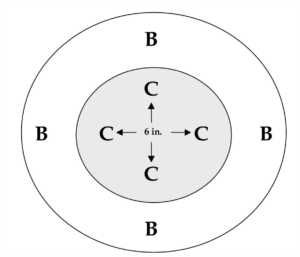
Figure 2. Wampanoag Corn & Bean Mound. Corn is planted 6 inches apart in the flat top of the mound. Beans are planted halfway down the slopes on the sides of the mound. Drawing by Mardi Dodson. Concept taken from Native American Gardening by Michael J. Caduto and Joseph Bruchac.
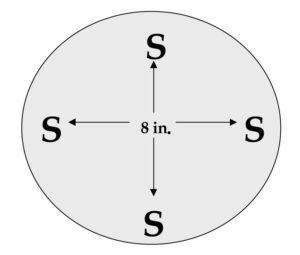
Figure 3. Wampanoag Squash Mound. Drawing by Mardi Dodson. Concept taken from Native American Gardening by Michael J. Caduto and Joseph Bruchac.
Squash seedlings are planted at the same time as the beans. Construct rounded mounds 3 inches high and about 1 foot across at the base. The squash mounds are staggered between the mounds of corn and beans (see Figure 1).
Traditionally, four seedlings are planted in the top of each mound. The seedlings are arranged to represent each of the four sacred directions (see Figure 3). Both winter and summer varieties are planted, including pumpkins, acorn squash, and summer crookneck squash (Caduto and Burchac, 1996).
Sunflower seeds are planted at the same time as the corn. The smaller-flowering common sunflower, Helianthus annus, is traditionally grown in a Wampanoag Three Sisters garden. The sunflower mounds are located at the north edge of the garden (see Figure 1). The mounds are spaced about three feet apart from center, with three seeds planted (one seed per hole) atop each mound. The sunflowers seeds are traditionally harvested after the first frost (Caduto and Burchac, 1996).
Hidatsa Gardens
In the northern plains, the Hidatsa, Mandan, and Arikara peoples gardened along the floodplain of the Missouri River in what is now called North Dakota. Most of the tribes in this region used the Hidatsa garden design (see Figure 4). Hidatsa gardens are designed to have alternating, staggered rows of corn and beans, with sunflowers growing along the north edge of the garden. Squash is planted after every fourth row of corn and beans and around the east, south, and west edges of the garden (Caduto and Burchac, 1996).
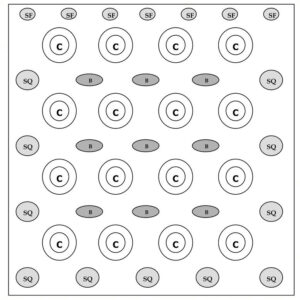
Figure 4. Hidatsa Garden Design. Drawing by Mardi Dodson. Concept taken from Native American Gardening by Michael J. Caduto and Joseph Bruchac.
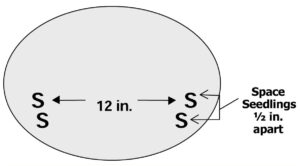
Figure 5. Hidatsa Squash Mound. Drawing by Mardi Dodson. Concept taken from Native American Gardening by Michael J. Caduto and Joseph Bruchac.
Sunflowers are planted as soon as the threat of frost has passed. As in the Wampanoag garden, three sunflower seeds are planted in small mounds three feet apart along the north edge of the garden. The Hidatsa garden differs from the Wampanoag garden when it comes to seed arrangement-all three seeds are planted in one hole. Hidatsa varieties of sunflower produce black, red, white, and striped seeds (Caduto and Burchac, 1996).
Plant squash indoors in peat pots or seed flats when the sunflowers are planted in the garden. Before planting in the garden, prepare the squash mounds (about 15 inches across at the base), with four feet between the centers of the mounds. The squash mounds are located along the east, west, and south edges of the garden in alignment with the rows of beans (see Figure 4). Squash seedlings are usually transplanted when they are about four inches tall and have put on their first set of true leaves (about two weeks after the corn is planted). To protect them from the heavy spring rains, four seedlings are planted on the sides of the mound in sets of two, 12 inches apart (see Figure 5) (Caduto and Burchac, 1996).
In the Hidatsa garden, there are usually four corn mounds per row of corn. Note that the rows of corn are in alignment but are staggered in comparison to the beans (see Figure 4). Hidatsa corn mounds are constructed in the same way as the Wampanoag corn and beans mound. The differences are that only corn is planted in these mounds and eight seeds, instead of four, are planted in the top of each mound (see Figure 6).
Growing corn together in bunches offers extra support and protection from wind and rain damage.
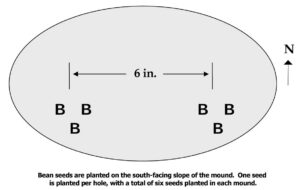
Figure 6. Hidatsa Bean Mound. Drawing by Mardi Dodson. Concept taken from Native American Gardening by Michael J. Caduto and Joseph Bruchac.
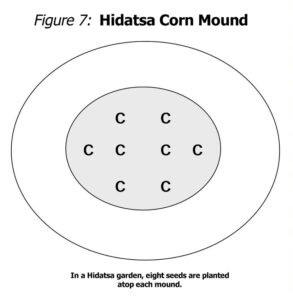
Hidatsa flint corn is planted in May in North Dakota when the leaves of the Gooseberry shrubs have emerged and fully formed. Corn is planted a week or two after the sunflowers have been planted. This flint corn is a semiarid variety with a growing season of about 70 days. It is advisable to research which corn variety works best for your zone and climatic conditions (Wilson, 1917).
Beans are planted at the same time as corn. In a Hidatsa garden, beans are planted separately from the corn in their own mounds. The bean mounds are located between the rows of corn in a staggered, alternating pattern (see Figure 4). The mounds are rounded ovals, about four inches tall by seven inches wide by 14 inches long. Traditionally, two people worked together to plant beans. The first person made six holes in the south-facing slope of the bean mound. This is done in one swift motion by thrusting both hands into the soil with the thumb and first two fingers extended to make two sets of holes spaced six inches apart (see Figure 7). The second person follows behind and plants one seed in each hole. A total of six seeds are planted in each bean mound (Wilson, 1917).
Zuni Waffle Garden

Figure 8. Zuni Waffle Garden. Drawing and design by Mardi Dodson.
The Zuni live in the Four Corners area of the Southwestern United States. This arid climate at altitudes over 7,000 feet makes gardening a special challenge. The Wampanoag and Hidatsa garden designs use raised mounds to keep the root systems from being waterlogged. In contrast, the focus of this garden is water conservation. The waffles are about 12 feet by 12 feet. Each individual square is indented and surrounded by a high rim. In each square, a single crop or combinations of crops may be planted (see Figure 8). This garden design will work anywhere in the country where dry summer conditions are experienced.
Traditionally, the crops are planted intensively with five to eight corn seeds in each hole to create clumps of corn similar to those in the Hidatsa garden. Corn seeds are planted four to eight inches deep in light sandy soils and about four inches deep or less in heavier clay soil. Beans and squash have the same planting depths and spacing requirements as corn (Talavaya Center, no date). The same number of beans (four to eight seeds) are planted around each clump of corn, one seed per hole. Only one or two squash plantings (four to eight seeds in each hole) are added to each waffle (see Figure 8) (Rosenthal, 1993). As with the other two designs, sunflowers may also be planted along the edges of the Zuni Waffle garden. Helianthus maximilianii, a small sunflower with flower heads about three inches wide, is most commonly grown in the Southwest (Buchanan, 1997).
Summary
Native American tribes of North America have made enormous contributions to the foods we eat today. The dynamic trio known as the Three Sisters not only thrive when they are planted together, they offer a well-balanced, nutritious meal. Over the centuries, many plant varieties and gardening styles were developed for each major climatic region. The Wampanoag (Northeast and South), Hidatsa (Plains), and Zuni waffle garden (Southwest) offer a range of gardening styles to accommodate most growing conditions found in North America.
Corn, beans, and squash have a unique symbiotic relationship in a Native American garden. Corn offers a structure for the beans to climb. The beans, in turn, help to replenish the soil with nutrients. And the large leaves of squash and pumpkin vines provide living mulch that conserves water and provides weed control. This ancient style of companion planting has played a key role in the survival of all people in North America. Grown together these crops are able to thrive and provide high-yield, high-quality crops with a minimal environmental impact.
Companion Planting & Botanical Pesticides: Concepts & Resources
By George Kuepper and Mardi Dodson, July 2001
Updated April 2016 by Justin Duncan, NCAT Agricultural Specialist
IP125
This publication is produced by the National Center for Appropriate Technology through the ATTRA Sustainable Agriculture program, under a cooperative agreement with USDA Rural Development. ATTRA.NCAT.ORG.

